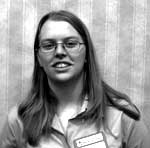
NEADS Conference 2004 - Right On!
Speakers
Jennifer Dunn

|
Biography
Jennifer Dunn is a third-year Social Work student at McGill University in Montreal. She joined NEADS in 2004 as a project consultant for the organization's project: “Inclusion of Students With Disabilities in College and University-Sponsored Activities.” Jennifer possesses a variety of experiences in the not-for-profit sector, including both student initiatives and work with persons with disabilities at the grassroots level.
Audio
PowerPoint
Synopsis
Inclusion In Campus Life: The NEADS Project
The presentation will share preliminary findings of research conducted by NEADS with campus activity programmers in 2004. The project team will present training materials developed for campus programmers, address barriers faced by students with disabilities, and demonstrate best practices.
Report
Jennifer Dunn, Project Consultant, outlined the NEADS Inclusion Project, explaining that the two partner associations for the project are the Canadian Federation of Students and the Canadian Organization of Campus Activities.
The objective of the project is to determine how accessible extracurricular activities are to students with disabilities. That objective differs from those of past NEADS projects, which have focused on academic issues and the transition from high school to post-secondary education. This project is the first in Canada to look at the accessibility of such activities at the post-secondary level. NEADS believes that extracurricular activities are a vital part of post-secondary education, and the organization decided to examine the issue.
To assist in finding appropriate solutions, the project will outline specific barriers faced by students with disabilities. The eventual goal is to create a training package for campus programmers and to identify concrete practices (including known “best practices”) that will make activities more accessible.
Many benefits accrue to participation in extracurricular activities. Participation fosters personal growth, increases health and wellness, builds social and professional networks, introduces and improves skills, promotes a sense of belonging, allows for exploration of personal interests, and contributes to increased commitment to school and academic achievement.
In phase I of the study, researchers sent a two-page questionnaire to campus programmers nationwide, asking questions about their activities. Researchers also met with programmers from four Saskatchewan institutions.
Results showed that the most popular activities were orientation activities, intramurals and sports events, and pub events. Programmers had assumed that their activities were accessible because the buildings were accessible. But because students with disabilities tend not to come forward with their concerns, the programmers had not considered the many needs of these students. Problems also arose with off-campus venues, which were not always accessible, and with transportation to and from those locations. Planners said that they were willing to accommodate students on a case-by-case basis as required, but that making all activities totally accessible was not really feasible.
Of the planners surveyed, 88% indicated that most or all facilities were accessible. Many student unions were willing to make accommodations if they were aware of the specific needs. Among respondents, 72% did not see barriers to making activities more accessible, and 58% had access to funding to make activities more accessible (although only 39% said that accessibility was considered when planning student elections).
Dunn mentioned these practical tips for greater accessibility:
- Provide event material in alternative formats.
- Advertise using a variety of methods.
- Provide sensitivity training for leaders of clubs and organizations.
- Include students with disabilities in planning and running events.
- Ensure that the event location and the washrooms are accessible.
In phase II of the project (currently underway), a survey is being distributed to students with disabilities. The survey asks about students’ participation in extracurricular activities and the kinds of barriers that they have encountered.
Preliminary results show that many students lack the time to participate in extracurricular activities due to the demands of their academic programs. Some were not interested in the activities available. Some noted that interpretation was not available outside the classroom. Many mentioned that clubs were located in older buildings that are not accessible. A few said that transportation barriers prevented them from participating in activities held off campus.
A training workshop was held just before the conference to discuss ways of making activities more accessible. Next steps will include the development of both online and offline training materials for campus programmers. Included will be two accessibility checklists that can be used for activities and events. The materials list the things that campus programmers can do to make events more accessible. A form that students with disabilities can fill out to request accommodations for accessible activities will also be circulated, as will a list from across Canada of best practices and ideas for promoting accessible activities.